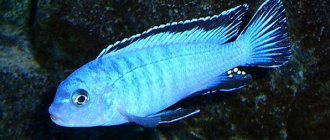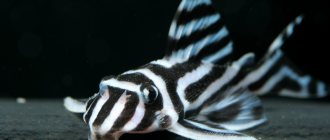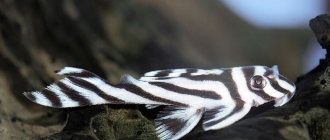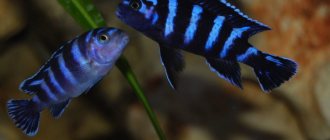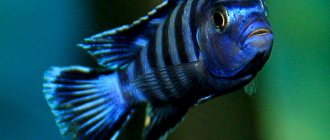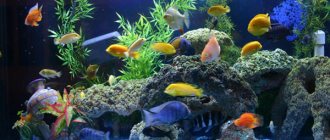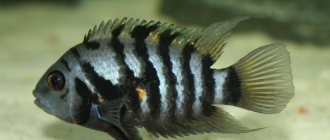One of the most popular fish among aquarists who prefer endemics to Lake Malawi is the zebra cichlid pseudotropheus. In its natural environment, this fish has about 50 different color variations. The following color forms are especially common: blue and cyan, gray, yellow-orange (yellow-orange female and blue male), double red zebra (red female and red male). These cichlids belong to the group of Malawian cichlids “mbuna”.
Among aquarium inhabitants, red zebra fish and mbunas with other color options are considered relatively large. At the same time, it is the red ones who are the least cocky. The length of their body when kept in captivity can reach 15 cm. In nature, the fish is somewhat smaller - about 8 cm. The body of an aquarium fish is slightly compressed from the sides and elongated in length. The dorsal fin is long. The anal fin is decorated with yellow spots with black edging. There can be from 7 to 9 stripes on the body. The color of the fish is significantly influenced by the conditions of detention and age. This fish has fairly large eyes and thick lips, and adult males have a fat pad on their forehead.
Content
It must be said that the zebra pseudotropheus has a very aggressive character. Even the calmest red zebra cichlids require a very thoughtful and serious selection of neighbors when kept in a common aquarium. The main recommendation for owners is to keep red zebra pseudotrophaeus only with other Malawian cichlids. The most advantageous design of an aquarium for keeping fish is to imitate their natural habitat conditions. A rocky bottom, replicating the underwater rocks of Malawi, is the best option. It is in an aquarium designed in this way that cichlids will look most advantageous.
To keep these fish, which are distinguished by their interesting behavior and bright colors, you need a fairly large aquarium - from 150 liters or more. This is the minimum volume required for the normal life of several aquarium fish pseudotropheus zebra. For these fish, clean and oxygen-rich water is important, which means installing an internal filter with good performance and a compressor is absolutely necessary. The temperature range that is comfortable for mbun is 24 - 26°C. For this cichlid, water with a pH level of 7.2 - 8.5 and a hardness of 8 - 20° is suitable. Weekly water changes are very important. In this case, about 25% of the total volume of the aquarium should be replaced. If you manage to achieve optimal housing conditions, this aquarium fish can easily live in an aquarium for up to 6 years.
Cichlids living in groups of 1 male and 1 female will feel most comfortable. At the same time, it is worth organizing enough secluded corners in the aquarium. This is necessary so that the females can hide from the pursuit of the male. It is important to remember the territoriality of the aquarium fish of the red zebra and mbun of other colors. The jaws are equipped with very sharp teeth, which are used not only for obtaining food. Red or blue zebras are aquarium fish that can easily attack and put to flight larger opponents.
Diet
Pseudotropheus zebra feeds on a wide variety of foods. But it is important to know that only 30% of it should be of animal origin. Your pets will completely approve of daphnia, cyclops, coretra, finely chopped beef liver and seafood. The remaining 70% of the diet is food of plant origin. It is also very diverse. Not only dry plant foods from well-known manufacturers of products for aquarists are suitable, but also chopped lettuce, dandelion, plantain, nettle, and rolled oats. The key to proper cichlid nutrition is variety and moderation. Excess food, especially of animal origin, will inevitably lead to obesity, which will not have the best effect on the health of the fish.
Breeding
The fish reaches maturity by the end of the first year of life. In zebra aquarium fish of red, blue and other colors, the males are somewhat larger, their dorsal fin is noticeably pointed. The best producers are cichlids that are 1.5 years old.
Since these aquarium fish care for their eggs, they do not necessarily need to be placed in a spawning tank to reproduce. The red zebra, like other color variations of this fish, retains its eggs in its mouth for three weeks. If you are planning to breed bluefish, then it is important to know that artificial incubation is also possible. Females of pseudotropheus zebra blue and other colors lay up to 100 eggs. Their number is influenced by age and conditions of detention.
After this, fully formed fry emerge from the eggs. All fry of blue zebra, gray, yellow-orange and other cichlids have a rather nondescript gray-brown color. Only after six months of life will they acquire the characteristic color of their scales and fins. The red zebra has certain differences in this regard. The fry are female red zebra fish, yellow-orange. The blue coloration of young males appears only in adulthood. For the first 6 months they are gray in color. The main food for fry is zooplankton.
Pseudotropheus pindani, also known as Pseudotropheus socolfa, is a small fish from the cichlid family that lives in the shallow waters of Lake Malawi, located in Africa. Fish lovers are attracted to interesting behavioral features that make Pindani's activities seem intellectual and meaningful.
Compatibility with other aquarium fish
Pseudotropheus zebra is a territorial and very aggressive cichlid that does not get along well with other fish. Therefore, it is recommended to keep them in a species aquarium. If the aquarium is large, other sized Malawian cichlids can be placed in it. It is better to do this while the fish are small. Do not forget that the fish are harem, that is, there should be more females than males. Synodontis and Pterygoplicht catfishes live well with cichlids.
Pseudotropheus pindani - appearance
In nature, there are two color options: completely blue fish or fish with a blue body and fins, having blue stripes in the upper part of the dorsal, on the anal and ventral fin. The Pindani's appearance has made these fish very popular among amateur aquarists. Pindani males grow up to 10–12 centimeters in length, while females are somewhat smaller: only 8–9 centimeters. It is curious that the fish do not have pronounced color differences between males and females: both have scales of a bluish tint, which, when the individual reaches sexual maturity at about 10 months, acquires delicate purple tones.
Appearance
How to distinguish between males and females
As a rule, males are much larger in size than females. You can also notice differences if you carefully examine the anal fin of the fish. In males it is longer and may have yellow spots. Males also differ from females in having more powerful fins, which allow them to feel more confident in fighting other males.
Habitat in nature
In nature, these fish are found only in one place: in the shallow waters of Lake Malawi, located in the country of the same name. Local residents call Pindani and other similar fish “mbuna”, that is, “rock dweller”. This name is due to the fact that the fish spends its entire life in rock crevices and on coastal reefs.
Breeding
In nature, cichlids live in harsh conditions. This had a significant impact on their reproduction process. Fish reach sexual maturity at the age of 8-12 months. The male has a brighter color than the female, he has bright oval spots on his anal fin, and his dorsal fin is pointed.
The male digs a hole in which the female lays eggs, 40-100 eggs with a diameter of 4 mm. The female collects the eggs in her mouth. The spots on the male's anal fin look like eggs. When the female tries to grab them, the male releases milk, which falls into the female’s mouth. Maturation occurs in the female's mouth.
The eggs are incubated for about three weeks. All this time the female does not eat. The fry are released from the mouth fully formed. They have a gray-brown, unremarkable color. Juveniles are painted at 6 months.
Reviews
I have been breeding Pindani pseudotropheus for about 5 years. I liked the look for its unpretentiousness and bright blue color. This color looks beautiful in clear water against a background of green algae. When breeding, I don’t remove females, since she hides her future offspring in her mouth. Matveeva Olga Vasilievna, 56 years old, Vladivostok
I liked the red look for its bright color. The species is unpretentious, males are not aggressive, and get along well with their neighbors. Advice for beginner aquarists: for a comfortable life, it is better to install decorative caves, grottoes, and large stones resembling rocks in the aquarium. Ivan, St. Petersburg
What do these “mbuns” eat?
To the surprise of novice aquarists, the red zebra prefers fresh vegetable food. Conscientiously crushed and formed into balls, it can be swallowed whole by a large mouth. Products prepared with spirulina, cyclops, shrimp, minced fish and other seafood will also be eaten with appetite. From food enriched with special vitamins and microelements, the color of the skin will become brighter, the size will become larger, and the mood will become more active.
Given their predatory nature, zebra cichlids can get their own food, especially if small fish live in the same aquarium with them and their spawning or viviparity occurs.
It should be noted that the appetite of healthy fish is significant. They eat so much that they exceed their own needs. Therefore, feed should be given sparingly, regularly cleaning the water from residues.
MORPH OF RED ZEBRA
It is believed that the light color of males is a xanthorid form of red zebras, a consequence of a natural mutation. During breeding, the fry must grow into both red and white males... But the trouble is, these arguments have not been confirmed by practice. From the Moscow, or better yet, from the domestic, “zebra” the same white and red fish grew... It would seem that let them be as they are, but then what? Who cares?
But, firstly, I was terribly curious why no one in the more than 30-year history of cultivating red zebras publicly raised the question of the discrepancy between appearance and name. And secondly, in the year 1986, I bought a pair of red zebras at the old “Bird” (the accumulated “school” money was not enough for more), which a year later successfully grew into fish of different sexes and began to actively reproduce. So, the male was an absolute copy of the female, i.e. orange-red color.
Then, one might say, I was just beginning my journey as an aquarist and didn’t really bother with the strange coloring of the male; on the contrary, at that time it seemed obvious to me: two red zebras - two red fish. White and red zebra - white and red fish, etc.
Photo of a male red zebra
According to the classification of that time, the entire complex of Malawian zebras belonged to the genus Pseudotropheus. The fish were called simply and ingenuously Ps.zebra, then a designation for the color of the fish was added for orientation in color varieties. The main forms were as follows: double red - Red Red (RR), red-blue - Red Blue (females are red, males are blue-blue; by the way, a morph completely lost for the domestic mass fish supply), white - W (white), piebald... and etc. And most importantly, all other color morphs, when growing, fully corresponded to the declared abbreviation.
Description
This fish is endemic to Lake Nyasa (aka Malawi), which is located in Africa. That is, it is not found in other bodies of water, and therefore it is unique. Moreover, there are many subspecies that differ significantly in color and other characteristics. This diversity is explained by the natural conditions in the lake where all these animals live.
Pseudotropheus belongs to the group of Mbuna cichlids. They stay near rocks and prefer to stay close to their natural shelters, which they make homes.
The fish has an elongated oval-shaped body. The scales are small, barely noticeable. The tail is powerful and symmetrical. The fin on the back is long, and on the chest and near the anus it is powerful and large. The muzzle is elongated, large lips and a large mouth stand out. By nature, it is a very flexible and nimble fish that easily maneuvers between various obstacles and decor, so it is very interesting to watch. This is a predatory cichlid, characterized by an aggressive disposition and developed intelligence. In artificial conditions they live up to 10 years.
How to equip an aquarium for such colorful inhabitants?
Natural habitat conditions can be successfully created in home ponds. The bottom can be lined with stone boulders connected by grottoes and caves. You can not only travel in them, but also hide in anticipation of prey.
The fish have a great need for clean aerated water. To ensure their normal functioning, an aquarium with at least 150 liters of water is required, equipped with a whole system of water purifying and health-improving devices. Thermal stability of water is required (within 23-24o), acidity index 7.5-8.5 and hardness within 15o. A weekly change of a quarter of the water volume is mandatory, even if only a few individuals live in the water house.
From the editor: Asphyxia of fish
Particular attention is paid to lighting. It is not so significant for adult fish.
In addition, they should have the opportunity to hide from bright electric rays, although in a beautifully falling light their color only benefits.
Reproduction
At one year of age, the species reaches sexual maturity and begins to form pairs. Before spawning, decorative caves or drainage pipes with a fish-sized diameter are installed in a common aquarium. In the chosen place, the female lays eggs, and the male fertilizes her. During 1 spawning, the female is capable of laying up to 100 eggs measuring 40 mm. To protect future offspring from other inhabitants of the aquarium, the female carries them in her mouth. After 17-21 days, the fry are born.
If you look closely, you can see the female's enlarged crop. The reason for this change is that the eggs are brooded directly in the mouth.
Plankton in small quantities is suitable as food for young animals. Newborn individuals have a uniform color (chocolate with a grayish tint). By six months, the color will change and look like its parents.
Cohabitation
As you know, pseudotropheus cannot boast of a friendly character, so living together with other species rarely ends well. If you want to breed various creatures in your aquarium, it is important to adhere to several rules and recommendations.
Cohabitation of zebras with other species rarely ends well, so it is better to keep them separately
First, you need to remember that in one group there should be a male and several females, preferably 2-3 individuals. In this case, the innate level of aggressive behavior will be significantly reduced.
If you want to populate a container with different fish, it is better to give preference to African species with a less pugnacious character. It would be very good if these were inhabitants of Lake Malawi with different sizes and colors. Otherwise, zebras will begin to show territoriality and will conflict with their neighbors.
If you want to expand your aquarium colony, then to do this you need to take several measures and provide the creatures with the proper conditions. Puberty of the species ends at the age of 8-12 months, after which individuals begin to show special interest in the opposite sex, courting females.
During the spawning period, they need a calm, relaxed atmosphere
There are times when an aquarist waits impatiently for new offspring of zebra fish to be born, but, unfortunately, this does not happen. To solve the problem, the most aggressive individual should be separated from the females, because during the spawning period they need a calm, relaxed atmosphere. A good stimulation for rapid reproduction will be increased nutrition. It is enough to try feeding your pets a little more often than usual.
Without a doubt, Pseudotropheus zebra is a real find for fans of aquarium fish. Her beauty and grace simply have no equal. At the same time, the creature does not require special care and easily takes root in every aquarium. If you understand the basic features of caring for pseudotropheus, then in a short period of time it will be possible to grow and breed an entire colony of fabulous representatives of the tropical ichthyofauna.
Origin
The red zebra was described by Konings in 1995. In nature, it lives on the rocky shores of Lake Malawi in Africa. It is found in five habitats: Minos Reef, Chilucha Reef, Metaangulu, Nhungu and Masinye. Other names under which this species can be found: pseudotropheus esterae, orange zebra cichlid, ester zebra, Metriaclima estherae (Metriaclima estherae is one of the acceptable scientific names), orange-blue zebra, mbuna. You can also find the color varieties Cherry Red Zebra and the recently introduced Super Red Zebra.
These fish live among rocks, feeding on the tough, fibrous algae Aufwuchs that attach to the rocks. They also eat insect larvae, nymphs, crustaceans, snails, mites and zooplankton.
Feeding
You can also use store-bought food designed specifically for this type of fish.
Under natural conditions, fish feed mainly on algae, sometimes supplementing their diet with plankton. In an aquarium, the pseudotropheus zebra should receive 70% of plant food in the total volume of food, the main of which should be lettuce, nettle, cabbage and sweet peppers. Vegetable foods should be crushed and scalded so that they become soft enough for the fish to eat them. The remaining 30% of the diet is live food. The best options are bloodworms, daphnia and coretra. Once a week it is useful to give a little black bread. You can also give the fish dry and frozen food, but this will make their color dull.
Diseases and prevention
How long pseudotropheus live depends on the conditions, but usually up to 5 years. They are hardy and have good health. The only common problem is injuries received during territorial fights. In order for wounds on the body to quickly heal, you should add salt (3 g per liter) and methylene blue (until the water turns pale blue) to the aquarium.
Less commonly, at home, “zebras” suffer from parasitic diseases: ichthyophthyriasis (the parasite lives under the skin) and Malawi disease (the digestive tract is affected). In the first case, to prevent the death of pets, malachite grun is dissolved in water, and the temperature is lowered by 5°C. In the second case, there is no cure or prevention, the fish dies.
Pseudotropheus are beautiful and unpretentious fish, suitable for a voluminous, green-rich aquarium. Watching their lives and relationships is great fun.
Motherland
Under natural conditions, pseudotropheus zebra lives in Lake Malawi, which is located in East Africa. Prefers coastal rocky and rocky areas for shelter from larger predators. It lives in the middle water column , where phyto and zooplankton and aquatic vegetation are found.
Pseudotropheus love spacious aquariums, in which they happily swim along the walls in the middle layers.
General information
Frontosa, or Cyphotilapia frontosa, is a ray-finned fish from the Cichlid family, until recently the only representative of the genus. You can meet this gorgeous fish only in the African Lake Tanganyika. Despite its impressive size and the need for a large aquarium volume, it is one of the most popular cichlids.
This majestic fish has an attractive striped coloration and a distinct fatty bump on its head. In the aquarium, it is slow and imposing, for which it received the name – Queen of Tanganyika.
Great intelligence can be read in the gaze of these majestic fish.
Frontoses are distinguished by high intelligence; when kept at home, they quickly remember their owner, allow themselves to be fed by hand, and are allowed to be petted.
A scientific description of the species was given to the fish back in 1906 by the English ichthyologist George Albert Boulenger. During its history, the fish moved several times from one systematic group to another, until it became the only representative of the genus Cyphotilapia.
However, in 2003, a group of ichthyologists from Japan described another species - Cyphotilapia gibberosa, living mainly in the southern part of Lake Tanganyika.
